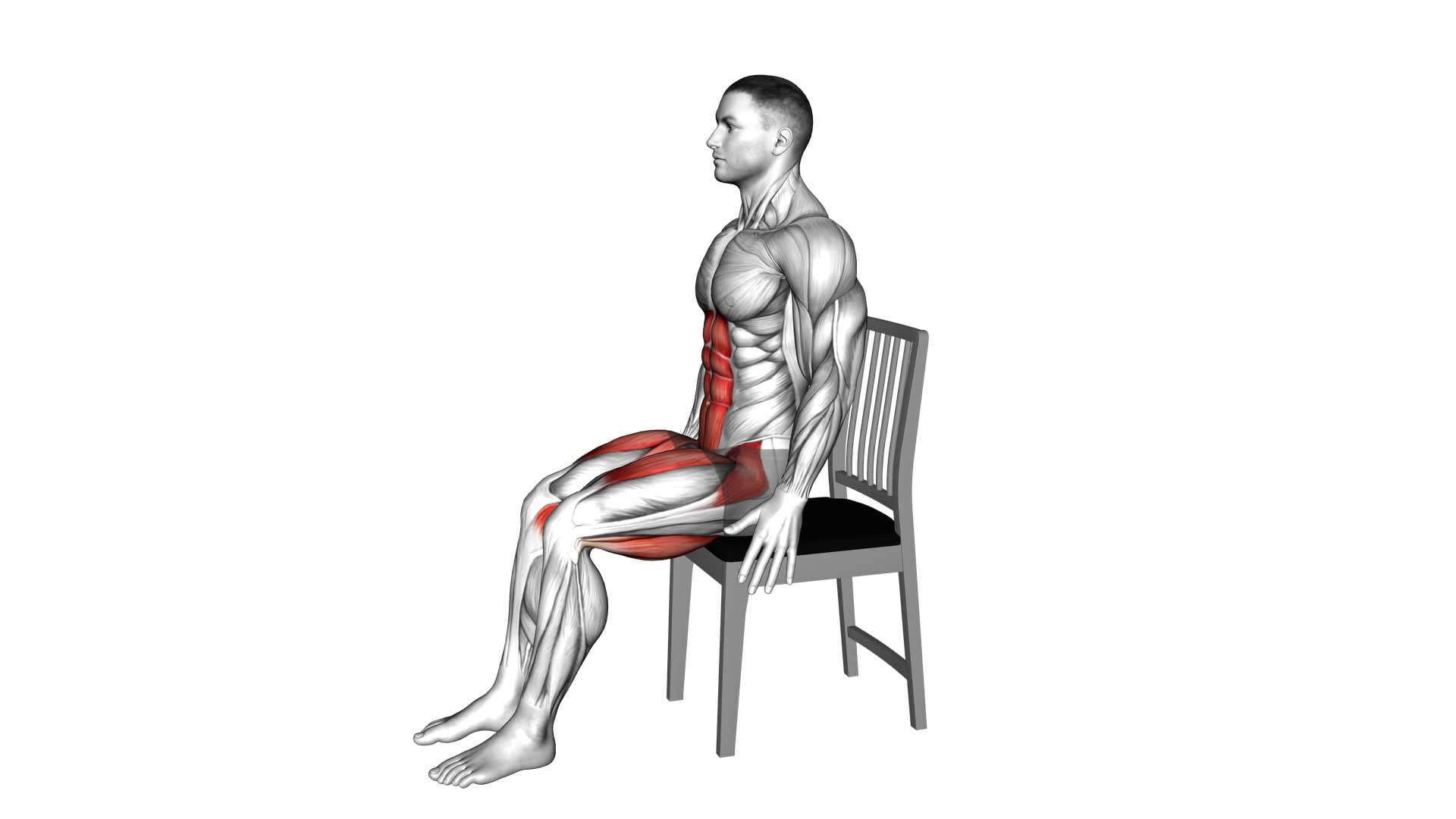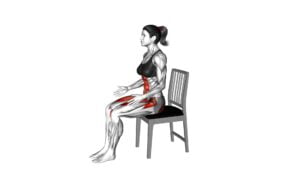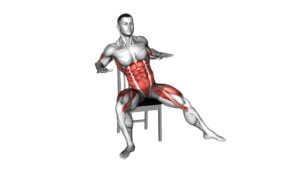Sitting March on a Chair (male) – Video Exercise Guide & Tips

Looking to stay active while sitting? Get ready to march on a chair! In this video exercise guide, we'll show you how to properly perform the sitting march on a chair, with tips to maximize your workout. Avoid common mistakes and learn modifications to suit your fitness level.
Watch This Exercise Video
Increase the intensity and get moving with this convenient and effective exercise. Grab a chair and let's march towards a healthier you!
Key Takeaways
- Sitting March on a Chair can improve blood circulation and deliver oxygen and nutrients to muscles.
- It can strengthen back and abdominal muscles and improve posture and alignment.
- Modifications and variations can be made for limited mobility or balance issues.
- Common mistakes to avoid include slouching, lifting knees too high, and not maintaining a steady pace.
Benefits of Sitting March on a Chair
What are the benefits of doing a Sitting March on a chair?
The Sitting March on a chair is a simple yet effective exercise that can offer numerous benefits for your health and well-being. One of the key benefits is increased blood circulation. As you perform the Sitting March, the rhythmic movement of your legs helps to stimulate blood flow throughout your body. This can aid in delivering oxygen and nutrients to your muscles, improving overall circulation and promoting better cardiovascular health.
Another benefit of the Sitting March on a chair is improved posture. When you engage in this exercise, you're required to sit up straight and engage your core muscles. This helps to strengthen your back and abdominal muscles, leading to better posture over time. By maintaining proper alignment, you can prevent or alleviate issues such as back pain and poor spinal alignment.
With increased blood circulation and improved posture being just some of the benefits, it's clear that the Sitting March on a chair can be a valuable addition to your exercise routine. Now, let's move on to the next section and explore the proper technique for performing the Sitting March on a chair.
Proper Technique for Sitting March on a Chair
To properly perform the Sitting March on a chair, begin by sitting up straight and engaging your core muscles, as discussed in the previous subtopic. Here are some key points to keep in mind:
- Position yourself on the edge of the chair with your feet flat on the floor.
- Keep your back straight and shoulders relaxed.
- Lift one leg off the ground, bending at the knee, and bring it up towards your chest.
- Lower your leg back down to the starting position and repeat with the other leg.
- Remember to maintain a controlled and steady pace throughout the exercise.
- Make sure to breathe steadily and avoid holding your breath.
Modifications and variations for the Sitting March on a chair can help tailor the exercise to your specific needs:
- If you have limited mobility or balance issues, you can perform the exercise with one leg at a time, instead of alternating.
- To increase the intensity, you can add ankle weights or hold light dumbbells while performing the march.
- For a seated cardio workout, you can increase the speed of the march or incorporate arm movements.
By following these proper techniques and exploring modifications and variations, you can make the most out of your Sitting March on a chair routine.
Now let's delve into the common mistakes to avoid in this exercise.
Common Mistakes to Avoid in Sitting March on a Chair
To avoid common mistakes in the Sitting March on a chair, it's important to maintain proper form and technique throughout the exercise. By doing so, you can prevent injuries and improve your posture.
One common mistake to avoid is slouching or hunching your back. This not only puts strain on your spine but also compromises the effectiveness of the exercise. Instead, sit up straight with your back against the chair, engaging your core muscles.
Another mistake to avoid is lifting your knees too high. While it's important to bring your knees up towards your chest, excessively high lifts can strain your hip flexors and lower back. Aim for a controlled and comfortable movement.
Additionally, make sure to keep your feet flat on the floor throughout the exercise. Lifting your heels can cause instability and increase the risk of injury.
Remember to maintain a steady pace, breathing naturally, and focusing on the movement of your legs.
Tips to Increase the Intensity of Sitting March on a Chair
To increase the intensity of Sitting March on a Chair, you can try incorporating resistance bands or weights into your workout. Here are some tips to help you take your seated march to the next level:
- Resistance bands: Attach a resistance band around your legs, just above your knees. This will add resistance and engage your leg muscles even more as you perform the march. You can also try using a thicker band for added difficulty.
- Weighted objects: Hold onto dumbbells or weighted objects while performing the seated march. Start with lighter weights and gradually increase the load as you get stronger. This will challenge your upper body muscles and increase the overall difficulty of the exercise.
- Advanced modifications: Once you feel comfortable with the basic seated march, you can experiment with more advanced variations. For example, you can try lifting one leg off the ground while marching with the other, or increase the speed and intensity of your movements.
Modifications and Variations for Sitting March on a Chair
To further challenge yourself and add variety to your workout, try incorporating modifications and variations into your Sitting March on a Chair routine.
Chair modifications can help target specific muscle groups and increase the difficulty level of the exercise. One modification you can try is elevating your feet on a step stool or sturdy books. This will engage your core and challenge your balance as you perform the sitting march.
Another modification is to hold a pair of dumbbells or water bottles in each hand while you march. This will add resistance and work your upper body muscles as well.
In addition to modifications, there are also various sitting march variations you can try. One variation is the double march, where you lift both legs off the ground at the same time and march in place. This will increase the intensity of the exercise and provide a greater challenge for your lower body muscles.
Another variation is the speed march, where you perform the march at a faster pace. This will elevate your heart rate and provide a cardio boost to your workout.
Frequently Asked Questions
How Many Calories Can You Burn by Doing the Sitting March on a Chair Exercise?
If you're wondering about the number of calories burned by doing the sitting march on a chair exercise, incorporating this movement into your daily routine can help with weight management.
Whether you're a beginner or advanced, there are variations of the sitting march that you can try. This exercise is a great way to engage your leg muscles and get your heart rate up, leading to potential calorie burning.
Can the Sitting March on a Chair Exercise Help Improve Balance and Coordination?
Improving stability and coordination is possible with the sitting march on a chair exercise. This seated exercise can help you enhance your balance and coordination by engaging your leg muscles and challenging your core.
It serves as a great alternative to standing exercises for individuals with limited mobility or those who prefer sitting workouts. Incorporating the sitting march on a chair into your routine can be a beneficial addition to your fitness regimen.
Is It Necessary to Warm up Before Performing the Sitting March on a Chair Exercise?
Before performing the sitting march on a chair exercise, it's necessary to warm up. Warming up helps prepare your body for the exercise by increasing blood flow and flexibility, reducing the risk of injury.
Additionally, warming up can improve the effectiveness of the exercise and enhance your overall performance.
To perform the sitting march on a chair exercise effectively, make sure to sit upright with proper posture, engage your core muscles, and maintain a steady rhythm while lifting your knees.
Can the Sitting March on a Chair Exercise Be Modified for Individuals With Limited Mobility?
Yes, the sitting march on a chair exercise can be modified for individuals with limited mobility. There are various sitting march variations and adaptive chair exercises that can be done to accommodate different levels of mobility.
These modifications can include using resistance bands, incorporating arm movements, or adjusting the height of the chair. By making these modifications, individuals with limited mobility can still benefit from the seated march exercise and improve their strength and flexibility.
How Often Should the Sitting March on a Chair Exercise Be Performed for Optimal Results?
To get optimal results from the sitting march on a chair exercise, it's important to know how often to perform it.
The frequency of this exercise can vary depending on your fitness level and goals. However, for seniors, it's generally recommended to do this exercise at least 2-3 times a week.
Regularly engaging in the sitting march on a chair exercise can help improve strength, flexibility, and cardiovascular health, making it a beneficial addition to any senior's fitness routine.
Conclusion
In conclusion, sitting march on a chair is a great exercise for those looking to improve their lower body strength and flexibility. By following the proper technique and avoiding common mistakes, you can maximize the benefits of this exercise.
Additionally, incorporating modifications and variations can help increase the intensity and challenge your muscles further.
So grab a chair and start incorporating sitting march into your exercise routine for a stronger and healthier body.

Author
Years ago, the spark of my life’s passion ignited in my mind the moment I stepped into the local gym for the first time. The inaugural bead of perspiration, the initial endeavor, the very first surge of endorphins, and a sense of pride that washed over me post-workout marked the beginning of my deep-seated interest in strength sports, fitness, and sports nutrition. This very curiosity blossomed rapidly into a profound fascination, propelling me to earn a Master’s degree in Physical Education from the Academy of Physical Education in Krakow, followed by a Sports Manager diploma from the Jagiellonian University. My journey of growth led me to gain more specialized qualifications, such as being a certified personal trainer with a focus on sports dietetics, a lifeguard, and an instructor for wellness and corrective gymnastics. Theoretical knowledge paired seamlessly with practical experience, reinforcing my belief that the transformation of individuals under my guidance was also a reflection of my personal growth. This belief holds true even today. Each day, I strive to push the boundaries and explore new realms. These realms gently elevate me to greater heights. The unique combination of passion for my field and the continuous quest for growth fuels my drive to break new ground.







